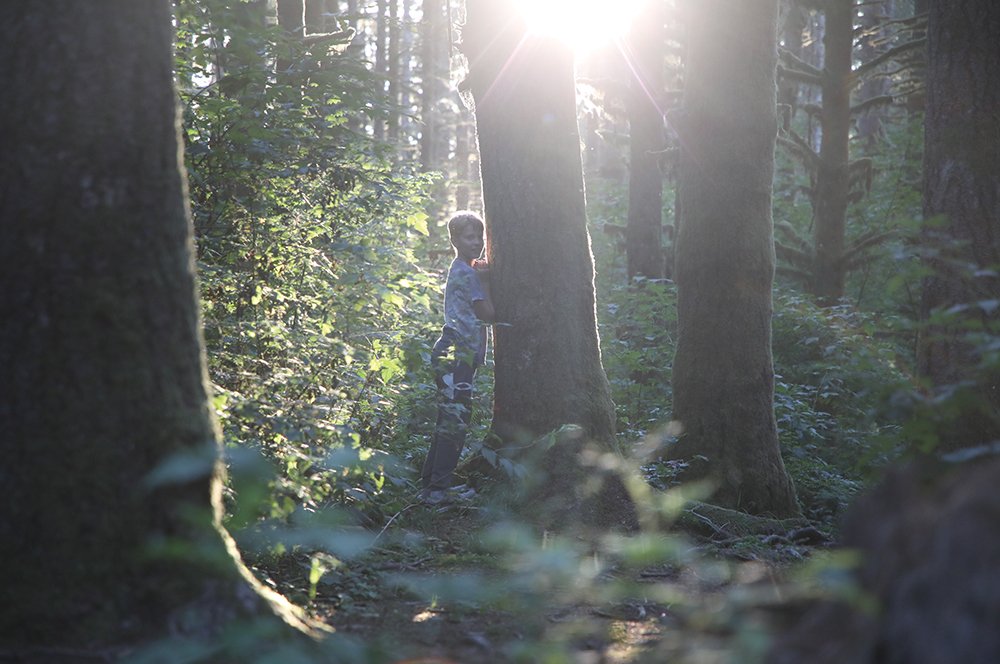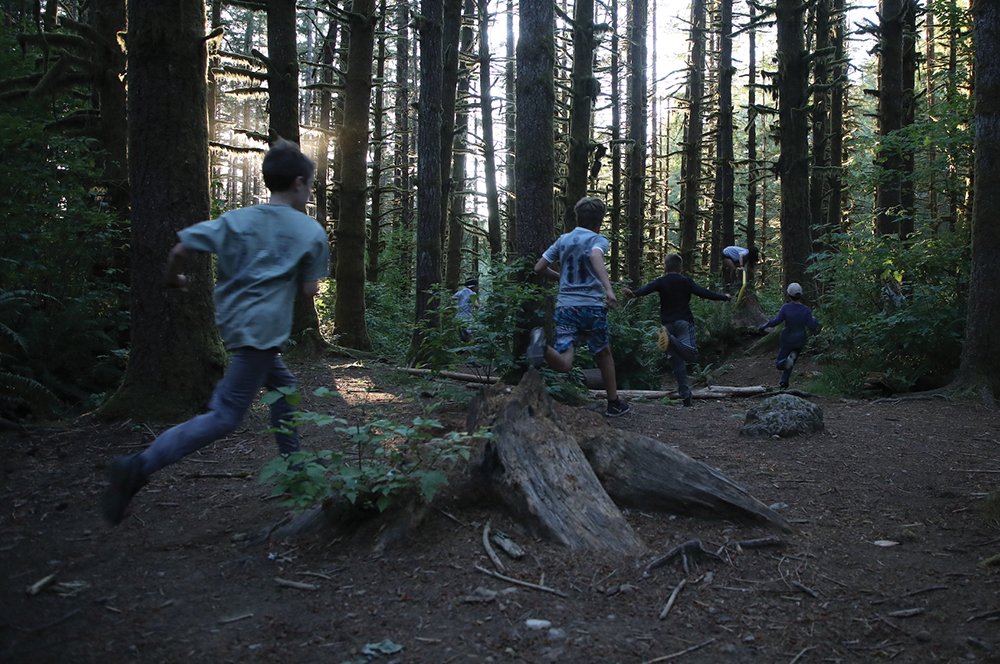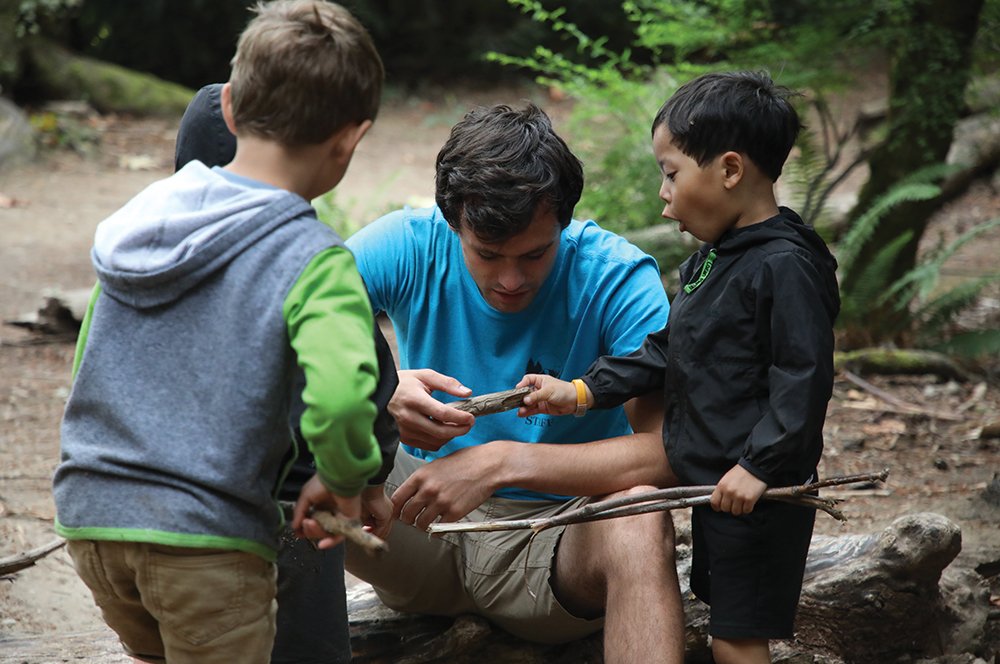For the majority of human history, children have played using their imagination and curiosity. In all that time—without television, video games, or mass-manufactured toys—kids spent most of their free time exploring natural surroundings. Nature was home.
As with most nature camps, the curriculum at Wilderness Awareness School involves a lot of play, bugs, songs, and mud. There are hands-on activities, time spent near water and trees, and roasting of food by a fire. But upon closer examination, one discovers that we do camp very differently.
Piquing Curiosity Is Key
Curiosity is the main element, and it’s ignited by utilizing Coyote Mentoring, a signature teaching technique. Throughout history, the coyote has appeared in stories as a master of cleverness—a cunning creature that often uses trickery to achieve a desired outcome. Coyotes live on the edge of a wild landscape, able to walk easily in both developed and natural habitats. A coyote also emulates awareness, fully tuned into using the senses.
Coyote Mentoring draws learning out of kids rather than forcing it in. This philosophy requires keeping a keen eye on children and watching for moments when something catches their attention—moments that create ideal learning opportunities. A Coyote Mentor notices what’s sparking a natural curiosity and uses that as a catalyst to engage campers in active learning. This process creates a space where mentors can pass on knowledge without campers realizing they are learning.

Teetering On The Edge
Enlisting the art of questioning is another way Coyote Mentors stir up organic curiosity. For example, rather than simply telling a group that a feather on the forest floor belongs to a Barred Owl, a Coyote Mentor engages a group with a series of questions. What colors are they seeing? What size bird do they think the feather belonged to? How long does it look like the feather has been there? How did this feather come to be on the ground? Mentors begin with a question that campers likely already have the answer to and then build to more challenging levels until an edge has been reached.
An awareness of a child’s edge is an essential component of Coyote Mentoring. A camper who reaches the edge of engagement may appear scared, distracted, or stuck. Mentors pay careful attention to the group and then masterfully draw a member to an edge, knowing when to take a break and move on, while also seeking prime moments for re-engagement. The time of day, communication style, learning style, and personality traits are all critical factors when gaining an awareness of a student. Instead of a Coyote Mentor adopting a certain teaching style, he or she caters to a camper’s preferred learning style based on observation.
Planting Seeds Engages An Audience
Instructors at Wilderness Awareness School don’t have a rigid agenda for each day. Instead, they may only plan events for the first part of the day, allowing the remainder to be determined by the natural flow of the students.
Coyote Mentors begin each day with a game to break the ice, have some fun, and release energy. They plant seeds during a game—perhaps someone is an eagle chasing several sparrows, or maybe a camper is running around an imaginary mud pit. The mentors watch for a moment when a few campers begin to tire of the game but before the entire group is no longer engaged. During this time, when the group’s energy is lower, they’ll take a break and listen to a story.
Storytelling is another opportunity to plant seeds. Stories can be a relatable way to draw out excitement and curiosity. For example, a mentor may tell a story about a young girl who has a special relationship with spiders and learns to weave from observing the eight-legged creatures. The group might then set off on a trek through the woods to look for spiders, curious to learn how a spider weaves!
When adventuring, campers can step into their own awareness of the natural world and decide which components of nature speak to them. The Coyote Mentor watches it all, choosing to ask the children relevant questions, or choosing to bring these curiosities into the curriculum later in the day.
Recalling the seeds planted earlier, mentors can further engage campers by referencing the morning game. Remember that imaginary mud pit? The children will be delighted when their afternoon adventure leads them to an actual mud pit, where they can reenact the morning’s game or simply dive in and get their hands dirty; a day of summer camp blossoms into a story of its own.

Opportunities To Explore
Using questions, storytelling, flow learning, and observation are all tools in a mentor’s toolbox to create relationships with the natural world and each other. In creating these connections, Wilderness Awareness School has for decades seen its students grow into humans who are resilient, compassionate, self-aware, and resourceful.
Although Wilderness Awareness School might seem like a simple nature camp—a way for campers to get some fresh air and meet new friends each summer—the experience is carefully curated by a bunch of coyotes. They know their campers, give them space to explore, orchestrate opportunities for curiosity, and push their edges. When a camper returns home and surprises the parents by leaving the tablet on the coffee table and asking if everyone can go for a hike, the work of the coyote is complete.
If you want to learn more, Wilderness Awareness School offers various training opportunities in the art of Coyote Mentoring. Coyote’s Guide to Connecting with Nature is the ultimate manual and can be found in our online store. We also run our popular Coyote Mentoring Weekend each spring. For the ultimate deep-dive into Coyote Mentoring, please check out our Nature Instructor Training program.
This article was written by Leah Carlson, Marketing & Communications Director at Wilderness Awareness School, and originally posted in Camp Business Magazine in 2022.
